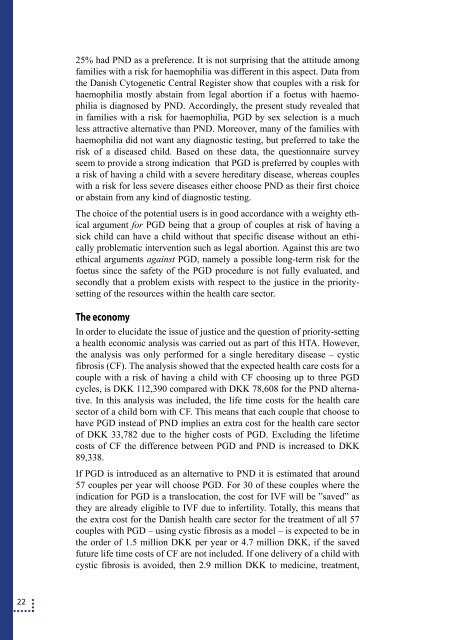Præimplantationsdiagnostik - Sundhedsstyrelsen
Præimplantationsdiagnostik - Sundhedsstyrelsen
Præimplantationsdiagnostik - Sundhedsstyrelsen
Create successful ePaper yourself
Turn your PDF publications into a flip-book with our unique Google optimized e-Paper software.
25% had PND as a preference. It is not surprising that the attitude among<br />
families with a risk for haemophilia was different in this aspect. Data from<br />
the Danish Cytogenetic Central Register show that couples with a risk for<br />
haemophilia mostly abstain from legal abortion if a foetus with haemophilia<br />
is diagnosed by PND. Accordingly, the present study revealed that<br />
in families with a risk for haemophilia, PGD by sex selection is a much<br />
less attractive alternative than PND. Moreover, many of the families with<br />
haemophilia did not want any diagnostic testing, but preferred to take the<br />
risk of a diseased child. Based on these data, the questionnaire survey<br />
seem to provide a strong indication that PGD is preferred by couples with<br />
a risk of having a child with a severe hereditary disease, whereas couples<br />
with a risk for less severe diseases either choose PND as their first choice<br />
or abstain from any kind of diagnostic testing.<br />
The choice of the potential users is in good accordance with a weighty ethical<br />
argument for PGD being that a group of couples at risk of having a<br />
sick child can have a child without that specific disease without an ethically<br />
problematic intervention such as legal abortion. Against this are two<br />
ethical arguments against PGD, namely a possible long-term risk for the<br />
foetus since the safety of the PGD procedure is not fully evaluated, and<br />
secondly that a problem exists with respect to the justice in the prioritysetting<br />
of the resources within the health care sector.<br />
The economy<br />
In order to elucidate the issue of justice and the question of priority-setting<br />
a health economic analysis was carried out as part of this HTA. However,<br />
the analysis was only performed for a single hereditary disease – cystic<br />
fibrosis (CF). The analysis showed that the expected health care costs for a<br />
couple with a risk of having a child with CF choosing up to three PGD<br />
cycles, is DKK 112,390 compared with DKK 78,608 for the PND alternative.<br />
In this analysis was included, the life time costs for the health care<br />
sector of a child born with CF. This means that each couple that choose to<br />
have PGD instead of PND implies an extra cost for the health care sector<br />
of DKK 33,782 due to the higher costs of PGD. Excluding the lifetime<br />
costs of CF the difference between PGD and PND is increased to DKK<br />
89,338.<br />
If PGD is introduced as an alternative to PND it is estimated that around<br />
57 couples per year will choose PGD. For 30 of these couples where the<br />
indication for PGD is a translocation, the cost for IVF will be ”saved” as<br />
they are already eligible to IVF due to infertility. Totally, this means that<br />
the extra cost for the Danish health care sector for the treatment of all 57<br />
couples with PGD – using cystic fibrosis as a model – is expected to be in<br />
the order of 1.5 million DKK per year or 4.7 million DKK, if the saved<br />
future life time costs of CF are not included. If one delivery of a child with<br />
cystic fibrosis is avoided, then 2.9 million DKK to medicine, treatment,<br />
22

















